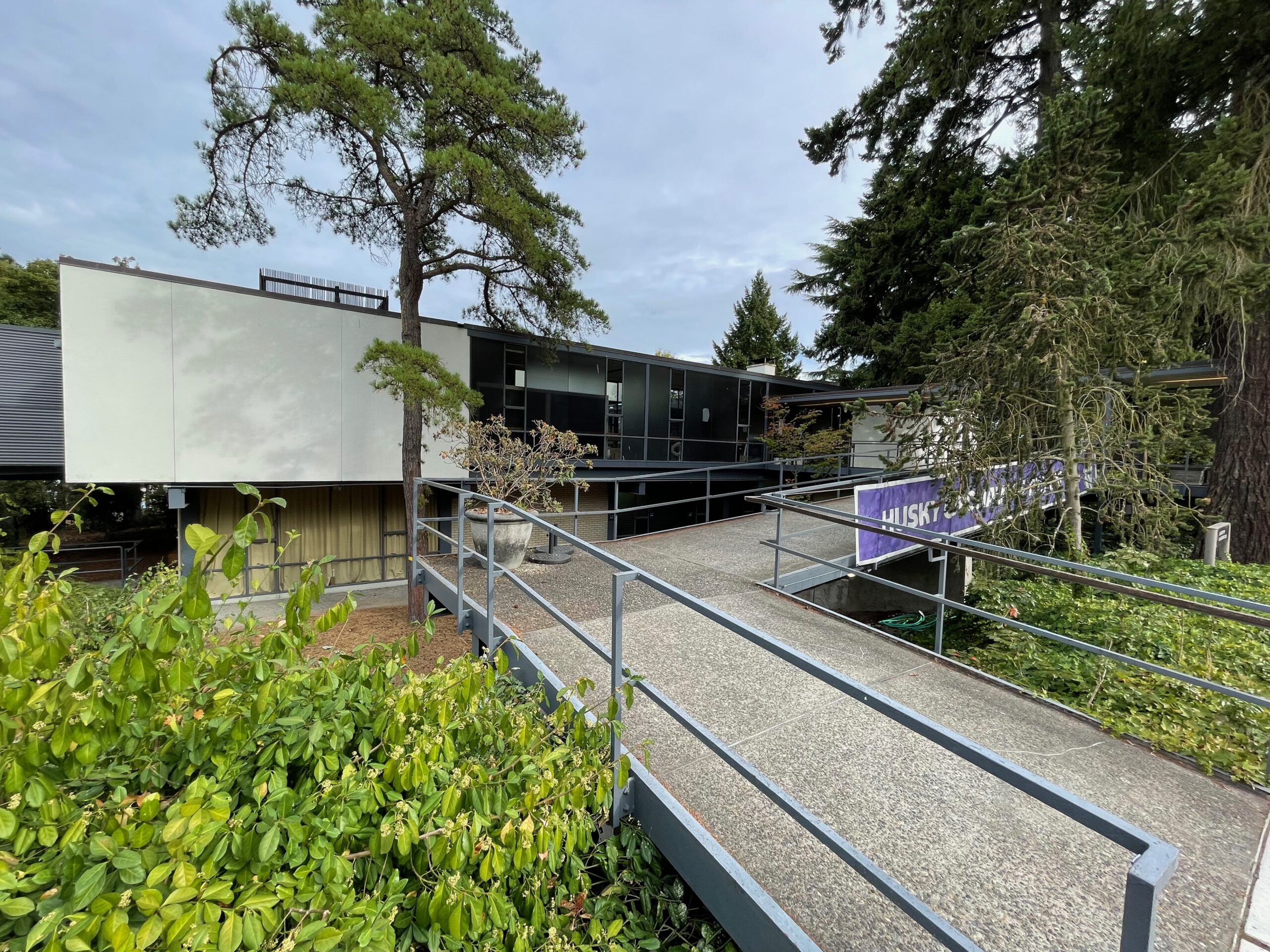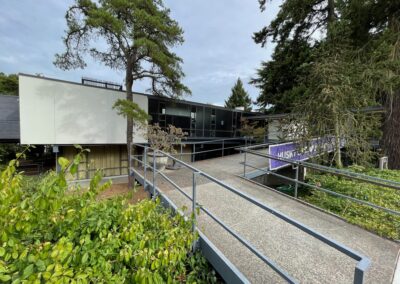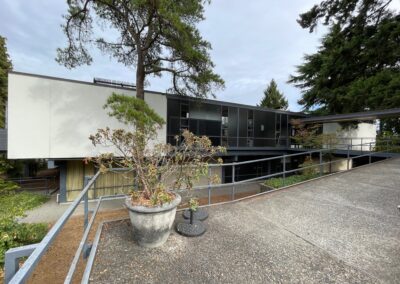
UW Faculty Club
4020 E Stevens Way NE, University of Washington, Seattle, WA 98195
The content below is from a 2021 Seattle Landmark Nomination Form
The History
The University of Washington Faculty Club is a striking post‐war Modern design achievement by two prominent local architects—Paul Hayden Kirk and Victor Steinbrueck, along with a landscape design by Garrett Eckbo of Eckbo, Dean & Williams.
Built in 1960, the two‐story building was placed on a steeply sloping site at a prominent location along the east edge of the central campus. Constructed concrete, steel, brick, stucco and glass, its cubic massing, white volumetric forms, full height window walls, exposed framing and strong relationship of interior and exterior spaces expressed a Modern design and Northwest sensibility. For nearly six decades the building served as a membership club for faculty, with dining and reception facilities, and as a rental venue. The lower floor conference room was utilized also for project reviews by the University’s Architectural Commission and other campus groups. The UW Club suffered economic impacts due to the pandemic closure of all dining facilities, and it laid off its staff in March 2020. At the end of June 2020, the Club’s Board of Directors were forced to close the club permanently and dissolve the non‐profit corporate entity that operated it. The building was then passed onto University Facilities.
The first University of Washington Faculty Club was located on 15th Avenue NE just outside of the central university campus. By the late 1940s however the building was showing signs of its age and discussions were raised about whether the Hoo Hoo house should be remodeled or rebuilt. To accommodate increasing numbers of club members, it was decided to demolish the Hoo Hoo House and build a new free standing structure.
One of the most notable requirements developed by the Faculty Club was to “build a contemporary‐style structure.” With that intention in mind, the commision reviewed choices of architects and narrowed it down to two local architects, Victor Steinbrueck and Paul Hayden Kirk, who were also UW architectural alumni. Local architect David McKinley, who eventually helped on the construction drawings of the building, reported it was probably Victor Steinbrueck who got the commission for the team. At the time, Steinbrueck was a faculty member who knew both the University President and other members of the campus architectural commission. Paul Hayden Kirk was a well‐established practitioner and had increasingly been awarded several design accolades. The decision to hire them may have been influenced, if not informally approved, by Paul Thiry, a committed Modernist.
In 1957, the commission decided to award the design commission to Kirk and Steinbrueck, who would collaborate on the design. While Steinbrueck was familiar with the commission, both he and Kirk were friends with Paul Thiry, and both had similar design aesthetics to Thiry. As such, the commission also chose the landscape architectural firm of Eckbo, Dean & Williams to prepare the landscape plan for the site (the plan, however, may have been the work of Paul Kirk as Eckbo’s name is misspelled).
The building’s grand opening was held on May 8, 1960 to much excitement by club members and the University community. An article in the Daily quoted Steinbrueck as saying, “It’s a satisfaction to see a building come into use and fulfill most of your desires.” Steinbrueck mentioned that, although the landscaping was not complete and some furniture had yet to arrive, the building was ready for operation. He explained that “all the commercially produced softwoods of the area [have] been incorporated into the structure.” He also outlined that some of the rough, outside wood of the former faculty club, the Hoo Hoo house, was added for texture to the walls of the lower level men’s lounge.
Shortly after its construction the building was published in the premier architectural magazine of the time, Progressive Architecture, in February 1961, and in the 1961 Steel Construction Digest. In 1960 it won several design awards including the Honor Award for Washington Architecture, and American Institute of Steel Construction Award, both in 1960. The building served as a welcoming gathering place for the university community for nearly six decades before it was closed in June of 2020. Prior to Covid‐19 related closures of all campus dining facilities, the UW Club had been organized as a 501‐C‐3 nonprofit with 1,800 members. Under this organization it had served as a private member facility, and the dining and other event spaces within it required member sponsorship. Facilities include the main dining room (Cascade Room), which accommodates receptions, plated or buffet‐style dinners for up to 250 guests, the south dining room the (Colleen Rohrbaugh Room) with reception and dining space for up to 50, and the Lake Washington Room, with meeting, reception, and dining space for up to 50. The lower level Yukon Pacific Room can be configured for meetings, lectures, or receptions for up to 100, and is often used as a review space by the University’s Architectural Commission. With the disbanding of the UW Club as an operational entity, the building has been passed onto University Facilities. It is presently vacant, serving only as a temporary site for testing facilities.
The UW Faculty Club was listed in the National Register of Historic Places on July 18, 2016 for its historically significant under Criteria “C” as a property that embodies the distinctive characteristics of a type, period and method of construction” as well as a building that “represents the work of a master.” The building’s design is recognized as a unique collaboration between two of the most celebrated architects in the Pacific Northwest during the middle of the 20th century, Paul Hayden Kirk and Victor Steinbrueck.
The Building and Site
The 13,000 square foot UW Club building is located on the eastern portion of the University of Washington’s Seattle campus. The building sits on the east side of East Stevens Way NE, the primary campus loop road, on a steep site where the topography slopes downward from the sidewalk edge to the lower level of the building, which is set back approximately 45’ from the roadbed.
This site has historic significance relating to the emergence of the campus during the Alaska Yukon Pacific Exposition (AYPE). The Faculty Club is located on the eastern portion of the fairground site at the location of a former Hoo House. The earlier building was for the Hoo Hoo, a lumbermen’s fraternal association. The half‐timbered, rustic style building was designed with Prairie‐style elements in contrast to the neoclassical style buildings of the AYPE.
The building overlooks a steep wooded slope to the east. Below there is Montlake Boulevard NE and the Union Bay Natural Area. Views of the Lake Washington shoreline, the east side communities of Bellevue and Medina, and Cascade foothills and mountains are provided from the site. Mount Rainier, further south, is also visible. The siting of the building was established to take full advantage of the sloping topography to exploit views, parking, and accessibility. As architect Steinbrueck described it, “All the architecture had to do was respect the site and the fine trees already there while providing a variety of necessary spaces.”
The building’s design minimized impacts on the ground plane to maintain surrounding existing trees, allowing them to be used in the landscaping design. The original site plan drawing shows planting in close proximity to the building within naturalistic plant beds, on a balcony and courtyard deck, and in setbacks around the building’s front (west) and south sides. Cotoneasters were planted in a row in the plant bed within the retaining wall, while other evergreens and native shrubs and groundcovers were planted throughout the site.
Historic photographs from 1960 of the building’s primary facades show the large, mature conifer trees that surrounded it, and new plantings on the east side of the parking lot. Landscaping in planters and site furniture was limited originally to the large central courtyard on the second floor. An original wood bench was placed across the eastern open side of this courtyard, which was accessible from the north and south corridors. A smaller terrace near the building’s southwest corner, accessed from a first floor bar, was paved and provided with perimeter steel railings, but no planters. Present landscaping includes trees planted in the first floor lightwells.
Constructed of buff‐colored brick, stucco, glass, and steel, the building’s facades utilize Modernism’s language of simple geometry, white volumetric cubic forms, horizontal bands of glazing and full‐height window walls, and exposed steel framing. The first floor mass was grounded on the site while the western portion of the second floor cantilevered some 6’ beyond the first floor. The eastern portion extended above the parking lot where it was supported by slender steel pilot‐like columns, set on 18’ centers.
Outward and inward views were important features of the original design, as were visual and physical connections and relationships of indoor and outdoor spaces. The outdoor spaces served to condition interior rooms with the sun and breezes of the natural environment. The original building design also played off the sense of solid volumes and open space, with a simple geometric mass seeming to float above the naturalistic landscaping and forested slope. The central interior courtyard situated on the upper floor, and linear two‐story lightwell to the west of it reinforced this sensation.
The central interior courtyard is a notable feature. This unique outdoor space is visible upon entry through the primary west doors at the upper floor, and from the initial sequence of spaces with the north‐south entry gallery. Protected from wind by the building on four sides, the uncovered outdoor room forms the heart of the main first floor level, providing daylight to the interior and forming a usable exterior space. The courtyard, which is used as a social gathering space, originally featured a simple horizontal wood bench and single railing placed full‐width in its open eastern end, which separated it from the adjacent open light well. This rail likely raised safety concerns, and it was soon replaced by a larger bench with full wood back support. The plan features an open lightwell to the east of the central courtyard. This open volume extends from the northern wall of the courtyard to the southern end of the building. The two corridors slice through the lightwell to allow the lower level more natural light.
The building was designed on a modular system made up of 18’‐wide structural steel bays, which were divided into further modulation of 9’ and 4.5’ depending on the function, size and infill of the spaces they comprised. Within the building, the service spaces are largely enclosed, while the primary program spaces are open within the steel frame. The steel frame was clad with panelized, lightweight stucco, with precise expansion joints, along with glass, and masonry infill. The first floor is clad primarily with light‐colored brick, along with a steel‐framed glazing system that makes up the entire system of window walls, windows, and doors. The upper level was finished with white stucco and windows, framed by square steel tubes. All original windows and doors were full height to allow as much natural light as possible. The single‐pane glass was alternately obscured with a light sandblast pattern or clear, depending on the privacy needs of the rooms. While the building was constructed with no mechanical cooling, many of the windows featured either awning or casement openings, or, in the case of the bar door, sliding doors that open to the lower southwest terrace. In addition, a steel sunshade, made up of paired steel elements and an integral catwalk, is placed along the east‐facing upper facade. A strong sense of openness and views were provided along the 9’‐wide pedestrian ramp and bridge that led in sections up from the sidewalk to the main entry, and from the southwest terrace. This openness was enhanced by the design of lightweight, minimal exterior railings at the ramp, deck, and lightwell perimeters.
The original rail system, which has been largely maintained, consisted of painted square and rectangular solid steel sections, which made up the posts and two horizontal rails. Consistent with the use of exposed and offset structural frames, the railings were offset from walkway or terrace edges, with a steel plate bolted vertically from the post to the base. The open side of a small terrace near the southwest corner of the building was treated similarly with the same, simple handrail as used along the entry walkway and ramp. The handrail system and ramps are character‐defining features of many buildings by architect Paul Kirk. Kirk was particularly sensitive in the way he integrated accessible ramps with building designs, perhaps in response to the mobility limits that were the lasting result of his having had polio as a child. In projects such as the Faculty Club it appears that he anticipated the passage of the ADA as well as current concepts of universal design for inclusive access solutions. Despite this insight, at the building’s first floor the primary access from the parking lot to the west entry door requires a series of steps.
Ceilings in the entry gallery and those in the south rooms are fitted with suspended acoustic tile. The entry passage features exposed concrete aggregate floors, which extend from the entry door to the exterior courtyard in the building’s center, while carpeting is provided on the remainder of the second floor. Other original finishes include a variety of local wood species used to create the wood paneling that clad most of the interior surfaces including the walls along the open stairway and those that enclose the spaces to the south of it. Ceilings are treated with slatted, stained fir panels hung from the steel frame, or, in limited locations, acoustic panels. Many types of commercial softwoods were used as interior wall paneling, including Hemlock, Alaskan and western cedar, ponderosa and lodgepole pine, as well as the salvaged exterior paneling from the original Hoo Hoo House, which were retrofitted to fit the space in the south lounge area. In the south lounge area, there is a large fireplace set in a Modern style inglenook in the north wall. An original sculpture is situated near the fireplace. The piece was created by an artist who was a contemporary of the design architects, Everett DuPen. Another piece by DuPen, dating from 1948, is located on the campus at the entrance to the Electrical Engineering Building.
The original Faculty Club has been well maintained, although some modifications have been made since its original design. In 1966 to 1968, the south dining room, which originally was a semi‐enclosed open volume below the cantilevered roof extending from the main dining space, was enclosed with glass to accommodate additional indoor dining. This project, completed soon after the original construction, was designed by Paul Kirk, using details and finishes that matched the original design.
The Architects, Victor E. Steinbruek (1911-1985); Paul Hayden Kirk (1914-1995)
Victor Eugene Steinbrueck was born in Mandan, North Dakota, and moved to Seattle with his family as a young boy. He graduated from Seattle’s Franklin High School and entered the University of Washington in 1928, beginning studies in the School of Fisheries. He changed focus to architecture in 1930 and graduated in 1935 with a Bachelor of Architecture.
Steinbrueck played a leading role in many of Seattle’s historic areas, and he was the leading advocate for the preservation of the Pike Place Market. In 1963, a proposal was floated to demolish Pike Place Market and replace it with a hotel, an apartment building, four office buildings, a hockey arena, and a parking garage. This plan was supported by the mayor, many city council members, and a number of market property owners. Steinbrueck and others formed an advocacy group, “Friends of the Market,” and fought against the development. An initiative passed in 1971 that created a historic preservation zone and returned the Market to public hands. In his advocacy for its preservation he used sketches and education to bring the lessons of urban historians such as Lewis Mumford and Jane Jacobs to Seattle. Many consider Steinbrueck as the single hand that saved the market from destruction.
Central to Steinbrueck’s civic work was his engagement of average citizens to care for the natural and built environment of the city he loved. His Guide to Seattle Architecture 1850‐1953 (1953) for the AIA national convention helped begin his legend as the citizen architect‐historian. With his sketches published in Seattle Cityscape (1962) and Seattle Cityscape #2 (1973) illustrated and documented the life of Seattle and its citizens seen through an architectural lens.
Through his drawings, he attempted to communicate the full range of Seattle’s built environment by looking at urban vernacular landscapes and buildings together with the public life that inhabited them. Steinbrueck led a series of historic surveys of neighborhoods in the mid‐1970s, with assistance from hundreds of volunteers, for Historic Seattle. The survey maps have helped guide neighborhood planning and preservation efforts for over 40 years. Steinbrueck had a long and influential career in teaching, architecture, urban design, and historic preservation. He taught in the Department of Architecture for three decades, from 1946 until his retirement in 1976, and served as the Departments Chair from 1962 to 1964. He was made a Fellow of the AIA in 1960, and received the Seattle AIA Medal in 1985. In special recognition for his efforts, Steinbrueck was named First Citizen of Seattle in 1977. Later, the mayor of Seattle named November 2, 1982 as Victor Steinbrueck Day. After his death in 1985, Pike Place Park was renamed Victor Steinbrueck Park in his honor.
Paul Hayden Kirk is one of Seattle’s best known mid‐century architects. Born in 1914 in Salt Lake City, he came with his family to Seattle in 1922. He studied architecture at the University of Washington and earned his bachelor’s degree in 1937.
Initially, Kirk’s own practice was small in scope. His reputation as an architect did not grow until the 1950s, primarily with private residences and medical clinics.The Faculty Club building, although similar in scale to a large medical clinic, was a unique structure among his list of accomplishments.
Many of Kirk’s residential projects of the mid‐1950s gained national attention. Among them was the Frank Gilbert House (1957) in the Highlands, the Bowman House (1956) in Kirkland, and the Evans House (1956) on Mercer Island. In 1957, several of his projects were selected by a jury for House & Garden magazine to receive four of five national design awards. Other work was featured in Sunset Magazine and McCall’s Book of Modern Houses. Rather than the industrial materials used by many modernists, Kirk brought in a regional sensibility by using local materials to carry out the modernist aesthetic. Local softwoods and rough cut stone, and glass were heavily relied on to carry out the forms influenced by national and international precedents. Around the time of the Faculty Club collaboration in 1959 and during the preceding decade, a distinct move away from the International Style can be seen in Kirk’s work, especially in his public buildings.
Kirk was a modernist who honored the human response in his architecture both in scale and materiality. He deeply admired both Scandinavian and Japanese traditions, both for their uniqueness to architectural space. In the Scandinavian, he saw the warmth and humanity of buildings. In Japanese buildings, he admired screening, modular systems, large, movable simple windows and doors, and the integration of inside and outside living spaces. He characterized his particular style as “sculptural, muscular, and flamboyant.” In all his designs, Kirk chose the simple rectilinear geometry of Modernism for its low cost and worked it as elegantly as possible.
This relationship of Modernist geometric form and the texture of the natural material is one of his trademarks. To maximize light in Seattle’s temperate climate, he expanded windows from floor to ceiling. Kirk was ahead of his time by being critical of the International Style and its known problems in heating and cooling. He emphasized awareness of the environment and the relationship to outdoor spaces, landscaping, and site, and fully integrated this idea into the Faculty Club building, eliminating any mechanical cooling, instead opting for cross ventilation and fresh air supply through operable windows.
Kirk was made a Fellow of the American Institute of Architects in 1984, and later went on to receive the first Seattle AIA Medal in Architecture along with Paul Thiry—the highest honor by his colleagues. Both Kirk and Steinbrueck received an Honor Award from the Seattle AIA in 1960.
The Landscape Architect, Garrett Eckbo (1910-2000)
Garrett Eckbo was born in Cooperstown, New York, in 1910, but was raised in California. At 22, he enrolled at Berkeley to study landscape architecture. After graduating, he spent a year working on garden designs for a nursery and then won a scholarship to study at the Harvard Graduate School of Design.
Eckbo announced his beliefs that, “what is good for the rich is good for the poor,” and that design required a multidisciplinary approach. He explored the relationships between private gardens and public space, and urban and suburban design, in both his master’s thesis project, Contempoville and “Small Gardens in the City.” The 1937 publication of his thesis in the architectural periodical Pencil Points brought Eckbo notoriety at home and abroad. He quickly understood the necessity of advancing his ideas in writing and published a series of additional articles in a variety of publications arguing for collaborative, cohesive design and planning, and stressing the interdependency of such environments.
In the post‐war era, Eckbo founded a new firm with Robert Royston, and his brother‐in‐law, Edward Williams. Eckbo, Royston & Williams soon expanded their practice from residential gardens to suburban parks and planned communities. From 1946, Eckbo headed the firm in the Los Angeles area with the assistance of Francis Dean. The firm’s early years were marked by a multitude of garden designs for the wealthy and the more modest, and by collaborations with Modernist architects on several developments. In 1950, Eckbo coalesced his ideas by publishing Landscape for Living, wherein he defined the modern discipline of landscape architecture for his professional peers and a broader readership. He continued to balance design and writing, and taught in the School of Architecture at the University of Southern California from 1948 to 1956.
In 1958, Eckbo, Royston and Williams decided to form their own firms: Royston Hanamoto & Mayes, and Eckbo, Dean and Williams. In 1964, Donald Austin became a partner and the firm was renamed Eckbo, Dean, Austin and Williams (later EDAW). Ultimately, the laboratory for progressive landscape design with a focus on the relationship between individual and community grew into a multinational planning corporation.
In 1963 Eckbo returned to the Bay Area to head the Department of Landscape Architecture at UC Berkeley, a position he held until 1969. He received the Medal of Honor from the American Society of Landscape Architects in 1975, retired as Professor Emeritus in 1978, and left EDAW a year later. His involvement in writing about the state and future of landscape architecture never abated, and he continued to believe in landscape design as an agent of societal change, publishing People in the Landscape two years before his death on May 14, 2000, in Oakland.
EDAW grew to become one of the most commercially successful and well‐known landscape architecture and urbanism firms in the world, which at its peak had 32 offices worldwide, developing a reputation in sustainable urban development and multidisciplinary design. The UW Faculty Club was one of the early projects of the combined design team, which demonstrates the breadth and scope of the firm and how Eckbo’s avant‐garde, modernist landscape ideas were combined with Williams’ concern for conservation and land management.


